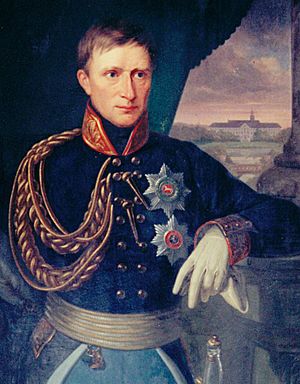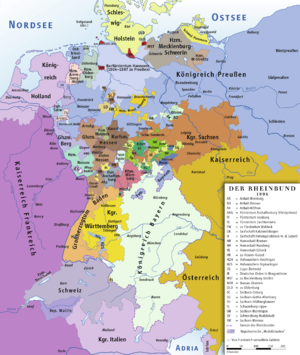Hanover Expedition facts for kids
Quick facts for kids Hanover Expedition |
|||||||
|---|---|---|---|---|---|---|---|
| Part of War of the Third Coalition | |||||||
|
|||||||
| Belligerents | |||||||
| Commanders and leaders | |||||||
| Units involved | |||||||
| Allied armies | Local garrisons | ||||||
| Strength | |||||||
| Britain: 25,000 Russia: 20,000 Sweden: 10,000 |
France: 4,000 Prussia: 50,000 |
||||||
| Casualties and losses | |||||||
| 1,000+ (British shipwrecks) | Unknown, minor | ||||||
The Hanover Expedition, also known as the Weser Expedition, was a military operation by Britain during the Napoleonic Wars. It was a plan to invade and take back the Electorate of Hanover, a German region that used to belong to the British King. This expedition was part of a bigger plan by the Third Coalition (Britain, Russia, and Austria) to attack Napoleon's forces in Europe.
British leaders William Pitt the Younger and Lord Castlereagh started planning this invasion in July 1805. They wanted to use British, Swedish, and Russian soldiers. A key part of their plan was to get Prussia to join them against France.
The first British troops, about 14,000 men led by Sir George Don, arrived in Hanover in November 1805. Later, more British troops joined, and Lord Cathcart took over command. However, the different allied armies struggled to work together.
By December, the situation changed dramatically. Napoleon won a huge victory at the Battle of Austerlitz, defeating the Austrian and Russian armies. This left the British forces in Hanover in a dangerous spot. To make things worse, Prussia then made a deal with France, agreeing to take control of Hanover itself. With French and Prussian armies moving in, the British army was ordered to leave. The evacuation finished on 15 February 1806, and Hanover was left to Prussia. The expedition didn't involve much fighting and didn't change the war's outcome, but it showed how Britain could quickly move troops by sea.
Contents
Why the Expedition Happened
Britain's Challenge on Land
In the early years of the French Revolutionary and Napoleonic Wars, Britain found it hard to fight France on land. Britain was strong at sea, controlling the oceans and taking many French colonies. But attacking France on its own mainland was difficult. The British Army was small and not ready to invade France, which had strong defenses. So, Britain mostly relied on its navy to block French ports.
New Allies and Opportunities
This changed in 1803 when Austria and Russia joined Britain to form the Third Coalition. With powerful allies, Britain could now plan land attacks, knowing they wouldn't face the French armies alone. Also, the creation of the King's German Legion in 1804 gave Britain more soldiers. Around October 1805, Napoleon stopped his plan to invade Britain and moved his army to fight the Russians and Austrians.
Taking Back Hanover
With many French soldiers gone, Britain saw a chance to attack North-West Germany. They were especially interested in taking back the Electorate of Hanover. This region had belonged to Britain's King George III until 1803, and only about 4,000 French troops were left there. The British Prime Minister, William Pitt the Younger, and his war minister, Lord Castlereagh, strongly supported the idea. They imagined landing small armies in different parts of Europe to make quick "pinprick" attacks, avoiding big battles. Taking Hanover would give Britain back its land and provide a base for future operations.
Planning the Attack

Castlereagh believed that many British soldiers were now free to fight abroad. At first, they thought about sending a very large army, but this would have been too hard to gather and transport. So, on 10 October, a smaller force was quickly put together. This army, led by Sir George Don, was to cross the North Sea.
Don's force included soldiers from the King's German Legion (KGL), a group of German soldiers fighting for Britain. It also had British Foot Guards and other infantry. In total, it was about 12,000 to 14,000 men. Don received his final orders on 16 October. The plan was to move quickly to avoid the harsh northern winter, which could freeze ports and rivers.
An important part of the plan was to get Prussia to join the Third Coalition. A politician named Lord Harrowby was sent to Berlin to talk to the Prussian court. He was allowed to offer Prussia a large sum of money to join the fight. British leaders believed that Prussia's support was key to the expedition's success.
The Expedition Begins
Landing in Hanover
Don's ships were delayed by bad weather and only arrived at Cuxhaven on 19 November. The journey was rough, and some ships had to turn back. Despite this, the expedition continued. A Swedish army of 10,000 men, paid for by Britain, was ready to attack from Stralsund. They were joined by 20,000 Russian soldiers.
The British were not the first allies in Hanover. A Russian force had already arrived to block Hamelin, a town still held by French troops. Don's army was welcomed warmly and quickly set up supply lines. The King's German Legion also recruited more local soldiers. Some British and KGL troops were sent to join the Russians at Hamelin. Meanwhile, the neutral Prussian army also entered French-controlled areas south of Hanover.
A Tricky Situation
Don's position was not very strong, but it wasn't immediately threatened. Napoleon had defeated an Austrian army at the Battle of Ulm, but this had stretched his own supply lines. This gave Britain's allies time to get ready. Don's forces spread out between the Weser and Verden, with Russian troops to their right.
Prussia was still neutral but was becoming unhappy with France. Pitt hoped Prussia would join the Coalition. If Prussia attacked Napoleon from the south, it would put him in a very difficult spot. Because of this, Pitt decided to send more British troops to Hanover, hoping to encourage Prussia to act. However, the situation was complicated because Prussia also wanted to control Hanover, and Napoleon had offered it to them.
More Troops Arrive

While Pitt decided what to do next, Don and the Russian commander thought about attacking Holland. But the Swedish forces were hesitant, and Prussia's plans were still unclear. Eventually, the attack didn't happen. It was decided that Don's spread-out forces would be brought together into one large army. On 27 November, Lord Cathcart was given command, bringing 12,000 more troops with him. Don became his second-in-command. Cathcart was named "Commander-in-Chief of British Forces in Northern Europe" and could even command Russian, Swedish, or Prussian troops.
Cathcart arrived in Hanover on 15 December and set up his headquarters. He began preparing for future battles, gathering his army around the Weser River. On 22 December, some British troops briefly fought with French defenders at Hamelin. This was the only fighting the expedition saw. Then, news arrived about the Battle of Austerlitz. On 2 December, Napoleon had completely defeated the Russian and Austrian armies. Austria surrendered, and the remaining Russian forces began to retreat. This made it very unlikely that Prussia would join the fight.
The Plan Falls Apart
Reinforcements and Shipwrecks
Cathcart's reinforcements arrived in the Weser River on 27 December. These included more infantry brigades and artillery. News of the Austerlitz defeat reached Britain on 28 December. Without the large Russian and Austrian armies protecting them, Cathcart's position in Hanover became very risky. However, his force stayed in Hanover for a while, hoping to still encourage Prussia.
The journey for these new troops was very difficult due to rough weather. Many ships were damaged or lost. For example, the ship Ariadne, carrying 300 soldiers, was wrecked near Calais, and everyone on board was captured. Half of another regiment was lost the same way. The 26th Regiment of Foot suffered the most, losing about 500 men in shipwrecks. In total, over 1,000 British soldiers died during the difficult sea crossings. Many units were so weakened that they couldn't fight.
Lack of Information
Cathcart found it hard to get good information about what was happening. On 28 December, Castlereagh in Britain complained that he knew almost nothing about the situation in Hanover, relying mostly on French newspapers. Cathcart's army knew even less. One officer reported that they had "very little intelligence in this place, except what they receive from England."
Leaving Hanover
Prussian troops were still in Hanover, but Cathcart wasn't impressed with them. He kept his army there, hoping Russia would keep fighting and Prussia would finally join the war. But he also started planning ways to retreat, in case the rivers froze and they couldn't sail home.
By 29 December, Castlereagh realized that the British force could no longer help its allies. He told Cathcart to support the Russians and Prussians if possible, but warned him not to trust the Prussians too much. Britain's Prime Minister Pitt was very ill, so the government started sending ships to Cathcart to prepare for an evacuation. On 5 January 1806, it was decided that no more troops would be sent to Hanover.
Two days later, they learned that Prussia had signed a treaty with France on 14 December. This treaty made Prussia and France allies and allowed Prussia to occupy Hanover. Prussia also began to take control of the Russian troops who had been left behind. With 50,000 Prussian soldiers moving into Hanover and rumors of a French attack, Cathcart was ordered to evacuate on 19 January.
Cathcart received his orders at the end of the month and quickly began the evacuation. His army had grown to about 26,000 men, partly because the King's German Legion had recruited more soldiers. The KGL and the British battalions that had suffered the most in the sea crossings left first. By 12 February, all the soldiers were on ships, and Cathcart left Hanover on 15 February.
What Happened Next
With the British gone, Prussia occupied Hanover. In Britain, Cathcart's remaining troops were spread out along the south coast to protect against a French invasion. France then forced Prussia to close all its northern German ports to British ships. This led Britain to declare war on Prussia on 21 April.
The Hanover Expedition was the last military plan by Prime Minister Pitt, who died on 23 January. It didn't achieve its goals, but it also didn't result in many combat deaths or much loss of equipment. Castlereagh was satisfied with Cathcart's actions. Some generals were angry about the failure, feeling that politicians had interfered too much. Critics suggested that if the expedition had gone to help other British forces in Naples, it might have been more successful.
However, the expedition did show that the British navy could quickly transport large numbers of soldiers across the sea. But lessons weren't fully learned. Later expeditions, like the Walcheren Expedition in 1809, were launched in a similar way and also had poor results.
Historians have different opinions on the expedition. Some say its failure was due to Britain's allies making mistakes, allowing Napoleon to win. Others are more critical, calling it a "farce." But most agree that the idea behind the expedition was good, but its success depended too much on the actions of other countries. One historian summed it up by saying the British "had enlisted a few hundred recruits for the King's German Legion, they had offended the King of Prussia, but they had not caused Napoleon a moment's worry." The Third Coalition finally ended in July 1806.
Images for kids



